27 Spawn Bag Fishing Secrets Used By Guides
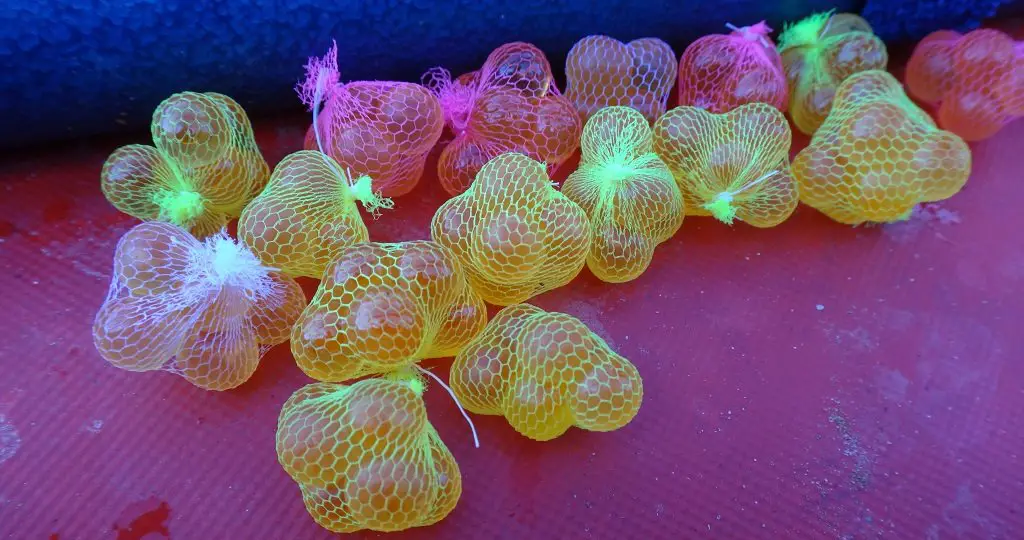
If you think fishing with spawn bags is as simple as putting the bag on the hook and throwing it out there, you would be wrong. I’m going to tell you the 27 most important tips and tricks of expert guides, answer some common question, anf provide top secret ways I make my spawn bags far more effective.
Spawn Bag Fishing Basics
- Size: Use the right size of spawn bag based on the conditions and the fish’s preference.
- Color: Use the right color based on the conditions and fish’s preference.
- Type: Know which eggs are best and which ones are not effective. This isn’t just about the species of eggs.
- Hooks: Use good hooks and use a hook size that matches the size of the spawn bag.
- Shape: Tie your spawn bags as rounded as possible.
- Presentation: Your presentation, which includes getting your spawn bag in the strike zone and covering the water effectively, can make a huge difference.
Spawn bags are also known as roe bags, spawn sacs, roe, roe sacks, spawn, eggs, or even eggs sacks.
Often, the loose fish eggs not tied into bags or sacks are just called roe or spawn.
What Are Spawn Bags?
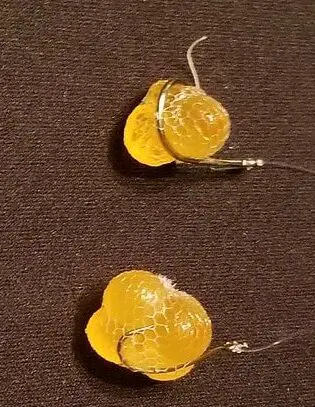
Spawn bags are usually made from trout or salmon eggs tied into a fine-colored mesh or netting, and they are used to present multiple eggs as bait.
Anglers combine the eggs together in a mesh bag to make a bigger bait and to secure the eggs to the hook.
Why Are Spawn Bags Considered The Best Steelhead Bait?
The simple answer is that spawn bags work in almost all situations because trout, steelhead, and salmon love eating eggs!
Because spawn bags are the most popular bait, they get used more than other baits, and therefore, more fish are caught on them.
I’d bet that most days, 80% of anglers fishing for steelhead and salmon will be using eggs of some sort. It’s probably half of that for trout fishing.
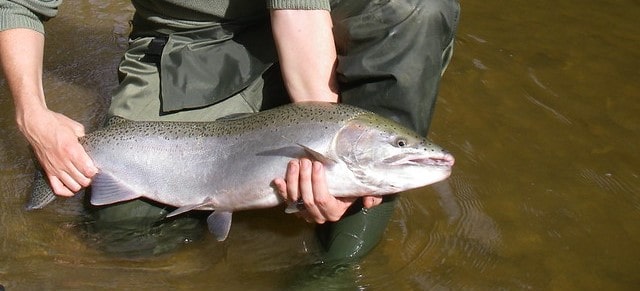
1. Big Profile Bait: What Size
Spawn bags are a big profile bait that stands out like a sore thumb and is the reason why more fish are caught on spawn bags. In very clear water use smaller bags, in dirtier water I use bags the size of a ping pong ball.
2. Scent: Tip For More Scent Attraction and More Fish
I don’t believe steelhead, trout, or salmon feed based on scent alone, but scent can play a part in the attraction process. Unlike other baits, a fresh spawn bag has a scent that the fish pick up on.
I believe steelhead, trout, and salmon feed more based on sight than anything else, and the scent of a spawn bag is gone a minute or two once it’s in the river. This is why beads, flies, and plastic worms catch so many steelhead, yet they have zero scent.
Guide Tip – A fresh spawn bag will milk or scent heavily on the first drift or two, which may work to your advantage, and it’s not uncommon to hit a fish on the first or second drift of a new spawn bag. That scent disappears quickly.
I puncture one egg in my spawn bag every three or 4four drifts to create an abundance of fresh scent. I push the hook point in gently to create a small hole, which milks slowly. It’s not uncommon for my clients to hit a fish immediately after popping an egg.
3. Using Spawn Bag Colors To Get More Bites
The color, which is a visual thing, can make all the difference some days.
I have seen fish hit pink or chartreuse spawn bags all morning, but by noon, they will only touch a white or blue spawn bag.
I do believe many fish are attracted to or triggered to bite because of the color of the spawn bag, but the color they want will change based on light conditions and water clarity.
Brighter colors are better in low-light, off-colored water and in faster water. Subtle and natural colors are better in clear and cold water.
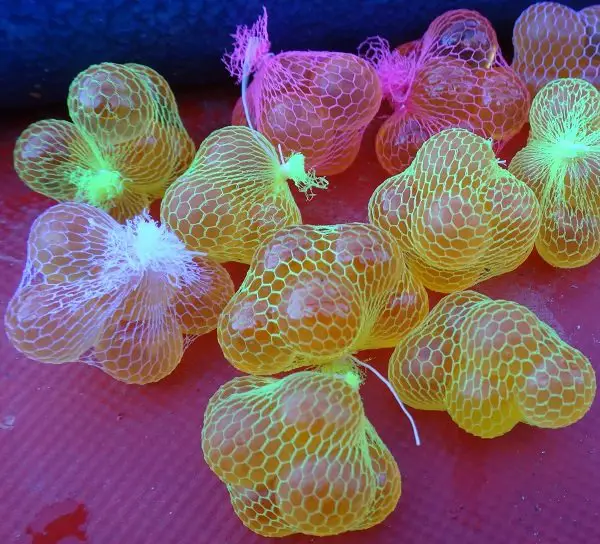
The fish can be very color-sensitive, and certain colors can be much more productive in certain conditions.
Some egg cures have a dye in them to color the eggs darker or lighter shades, and some guys prefer to change their egg colors using this method.
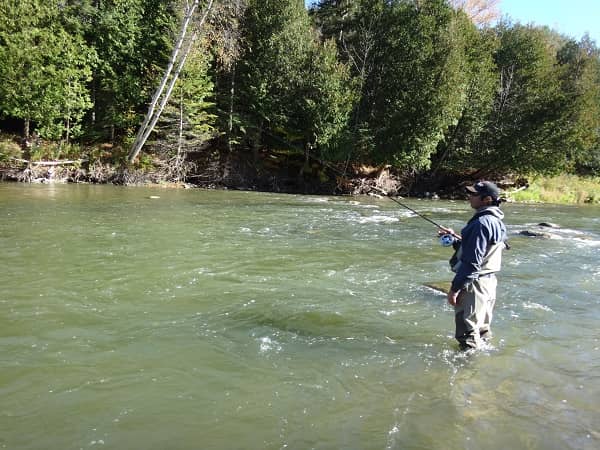
In certain conditions, like when the water is stained or dirty, a dyed egg can be beneficial and might help you catch more fish.
However, most of the time, I stick with the natural color of the eggs and then use the spawn netting for added color. This works very well.
- DIRTY WATER – If I can only see 8 inches or less into the water and the water is brown, I consider this to be very dirty and probably un-fishable. Best Netting Colors – Chartreuse, Red, Hot Pink
- OFF-COLORED Water – In eight to fourteen inches of visibility and slightly brown or off-colored or slightly dirty water, it’s very possible to hook some fish. Best Netting Colors – Chartreuse, Red, Hot Pink, Yellow, Bubble Gum Pink, Fire Orange, Orange.
- GREEN WATER – 14 to 24 inches of visibility and a greenish color as seen in the picture, this is what I would consider medium visibility and is often when the fishing goes from tough to very good. Best Netting Colors – Yellow, Pink, Orange, Salmon.
- Clear Water – 24 to 36 inches of visibility – This can be good fishing. Best Netting Colors – Salmon, Peach, White, Blue, and Light Purple.
- Very Clear Water – if the water looks like tap water and is so clear that you can see deeper than 6 feet. Best Netting Colors – White, Peach, Blue, Purple
WATER CLARITY | Spawn Bag Color | Spawn Bag Size | Hook Size |
Clear Water - over 30 inches of visability | peach, white, blue, light orange, salmon, light pink | 2 to 3 salmon eggs. Dime Size | #10 or #12 |
Medium Clear - up to 30 inches of visibility | yellow, pink, orange, salmon, hot pink, chartreuse | Dime sise to Nickle size - 4 to 5 salmon eggs | #8 or #10 |
Dirty - less than 12 inches of visability | chartrueuse, red, hot pink | qurter to dollar size - 5 to 8 salmon eggs | #6 or #8 |
4. Use The Right Spawn Bag Size
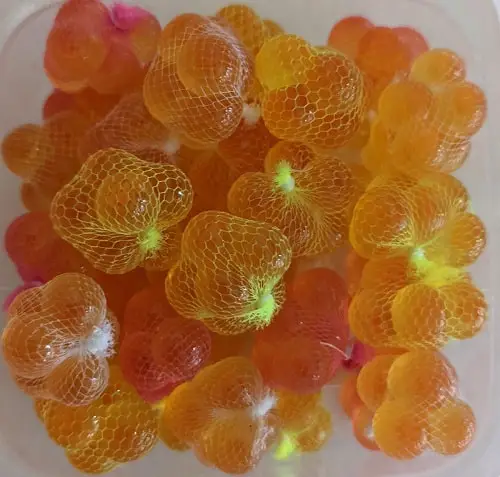
The size of the spawn bag is important because the fish can be selective on the size of the roe bags that they eat.
Just like the spawn bag color, the size of your spawn bag should also be based on water clarity.
- Dirty Water – Low visibility – Big spawn bags that are the size of a quarter or a ping-pong ball work best. I’ve been known to use golf ball-sized egg sacks, but these can only be tied in the scarf netting.
- Green and slightly off-colored water with medium visibility – Big spawn bags can work, but I prefer bags the size of a nickel or quarter.
- Clear Water – good visibility requires dime-sized spawn bags.
- Very Clear Water – Dime-sized or small micro spawn bags with two to three salmon eggs or three to five trout eggs. This is also when single salmon eggs are a good option.
In very clear water, I will often switch to beads. Check out my page, Fishing With Beads: 5 Guide Tips For More Fish.
5. Sinking Bag or Floating Spawn Bags
Fish eggs sink, therefore, spawn bags tend to sink, and that means that they get into the strike zone faster and will stay there longer than some other baits, which may be one reason why anglers catch more fish using spawn bags.
Getting your bait down fast and in the strike zone is always a good thing.
Sinking Bags: Most methods, such as float fishing, bottom bouncing, and drift fishing, you want sinking spawn sacks.
Floating Bags: The only time you want to add the little styrofoam egg floaters that make your spawn bags float is with bottom rigs and still fishing rigs to keep the bag up off the bottom.
Guide Tip: Learning how to get all your baits down fast and into the strike zone is much better than just relying on a bait like spawn bags that sink. Using my steelhead leader setup really helps. See it at Steelhead Leaders: Best Float Leader And 2 Proven Setups.
6. Speed Control For More Fish
Speed control is critical for catching more steelhead, salmon, and trout with any bait!
Anyone who has learned from me knows that I consider the speed of your bait in the strike zone to be one of the most important things to master if you want more fish to bite.
I believe that many anglers drag their baits too fast through the strike zone, which results in significantly less fish biting the bait..
I believe spawn bags are like little parachutes in the water, which is to your advantage. Their big round profile tends to drag and slow the bait down, which allows for a slower, more natural presentation, and that slower presentation is probably another reason why spawn bags catch more fish.
However, you must still do your part to ensure you get he right speed using a method known as trotting or checking your float.
See my page Controlling Your Speed For More Fish When Float Fishing.
7. Make Fish Hold On Longer
I believe anglers miss subtle hits all the time due to poor presentation.
To make the fish hold on longer I do three things.
- The Mesh – Use a tight mesh that gets stuck in their teeth, which won’t allow them to spit the bag out.
- The Cure – Do not use any egg cure or only use a known egg cure that the fish won’t spit out. I try to use uncured frozen eggs or eggs cured in salt or salt and sugar combinations. I do not use oil-packed eggs or other commercial or industrial egg cures that the fish will taste and spit out quickly.
- Hook And Bait – Rig your roe bag on properly to keep the hook point exposed and the hook gap open. In my experience, this allows for self-hook-ups from the line and the leader being pulled by the current and pulling the hook into the fish. You must also use the right hook.
8. When To Fish Spawn Bags
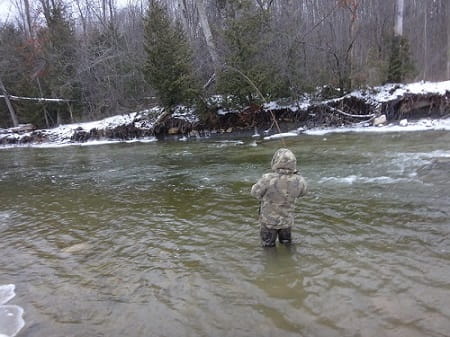
There are times of the year and certain conditions when spawn bags work well or won’t work well.
Many trout, steelhead, and salmon will either spawn in the spring or fall, so eggs will be a part of their diet at these times.
When To Use Eggs: I use eggs when other angles are not present and the fish are not seeing hundreds of egg sacks drifting past them. I also use eggs when other anglers are catching fish on eggs.
I will use eggs in lower visibility water and during low light.
Spawn bags also work well in slow or still water.
9. When Not To Use Spawn Bags
I have found that the fish will avoid eggs when they are pressured by anglers and are seeing lots of eggs drift past them for hours.
I don’t know how many times I’ve moved into a spot near other anglers that are all fishing roe bags and catching nothing, and I put on a Wooly Bugger or other effective fly and catch multiple steelhead in front of everyone while they catch nothing.
10. Use The Right Species Of Eggs
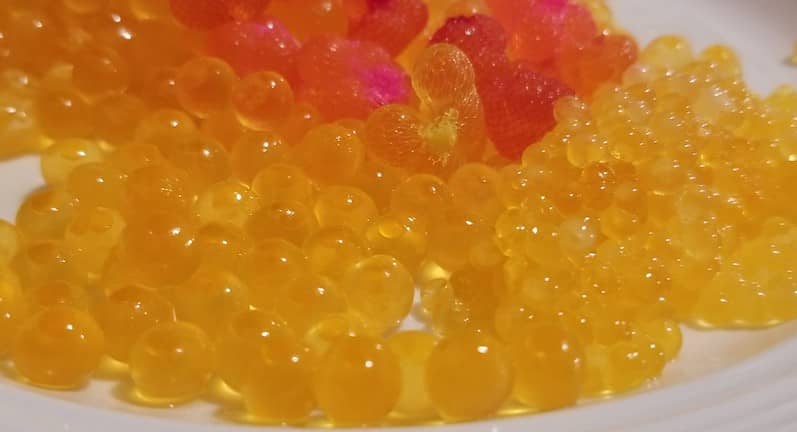
There are a lot of guys who will tell you that one species of eggs is better than another.
I know guys who will travel two hours to a river with migratory brown trout just to harvest brown trout eggs, thinking these are the best eggs for bait.
Other anglers will tell you that in the fall, when the salmon are in the river, you MUST use salmon roe, and when the steelhead is spawning in the spring, you MUST use rainbow roe.
And then there is the question about Chinook salmon eggs versus coho eggs, or brook trout eggs, or even Arctic Char eggs.
To be honest, once the eggs are tied into a roe bag, I rarely find that it makes a big difference what species the eggs are.
I have experimented for years where one of my clients would use salmon eggs, and another client would use rainbow eggs, brown trout eggs, or even brook trout eggs, and most of the time, there was little to no difference between one egg over another as long as they were all cured the same way.
11. Use The Freshest Roe Possible: Fresh VS Store Eggs
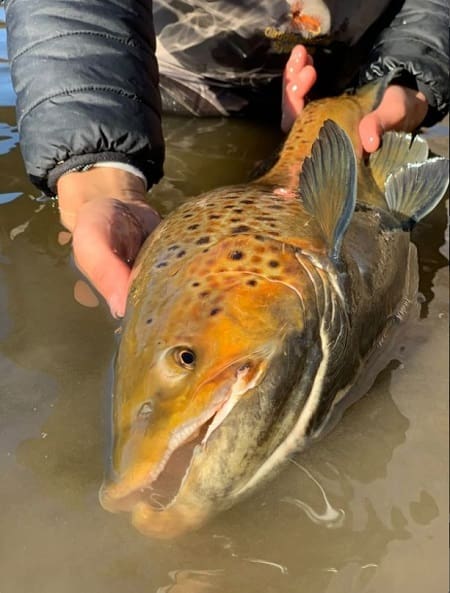
Based on my experiments, there is really no difference between cured eggs that you harvest from a fish at the river and the eggs in the store that are harvested from farm-raised fish and are salt-cured.
The exception is roe that was recently caught and not cured, which always seems to be very effective. The fresher the roe the better.
If you are going to buy roe from a store, I recommend the salt-cured roe, and I also recommend getting loose roe that you can tie in the appropriate sizes and colors for the river conditions that you are faced with.
Roe that you harvest yourself doesn’t need to be cured at all!
12. Water Curing Is Best: How I Do It
When I harvest a fish with loose roe, I milk the fish into a bag or some sort of fine mesh sack. I will often put them in a plastic bag and poke some small holes in the bottom to let the water drain out slowly.
I just let the eggs sit in river water for five minutes to harden them a bit so they don’t break easily when tying them or when fishing.
Then, at home, I pack the eggs into small baby food jars or zip-lock bags and freeze them in sizes just big enough for one or two days of fishing.
It’s that simple and works great for me.
13. Buy Loose Roe
GUIDE TIP – Buying pre-tied spawn bags may mean they might be too small, or they might be the wrong colors when you arrive at the river. Some guys, like me, will experiment on the river with big and small spawn bags and with different colors, and once I find what is working best I will tie up my spawn bags at the side of the river. Therefore pre-teid eggs are not the best way to go.
Guide Graham
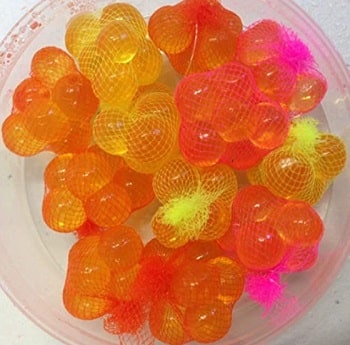
Salmon Spawn Sacks
These are Pre-tied spawn sacks using Coho eggs. These Spawn Sacks by Superior Outfitters get great reviews from users.
Check more prices at FishUSA and Bass Pro Shops
Other pre-tied spawn bags to consider are the Catchmore Spawn Sacs.
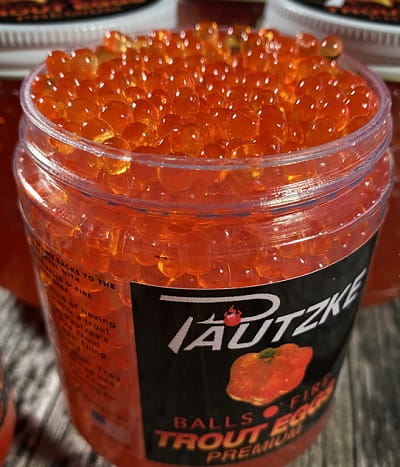
Loose Trout Eggs
The Pautzke Balls O’ Fire Trout Eggs are some of the best loose eggs for tying your own spawn bags.
Other loose eggs to consider are:
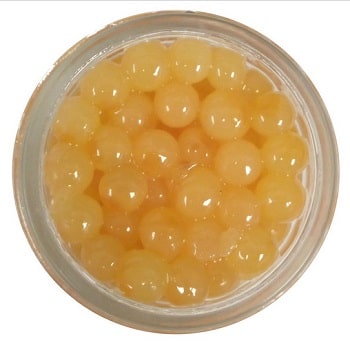
Single Salmon Eggs
The Pautzke Balls O’ Fire Salmon Eggs are great when you need to use a single egg on a hook. I have even tied them into spawn bags.
Other single salmon eggs to consider are the Atlas Fishing Bait Big Boy Salmon Eggs
14. Cured or Non-Cured Roe
I prefer non-cured roe over cured roe, and so do most anglers I know.
If you store the eggs properly, your non-cured eggs will last a week or two in the fridge and even a couple of years in the freezer.
The only advantage of curing your eggs is that the eggs may last longer in the water when fishing and the eggs that are cured will last much longer in the fridge and freezer.
I also find that cured eggs will tolerate being thawed and then refrozen multiple times compared to non-cured eggs.
15. Salt Cured Eggs
I have experimented with many different egg cures, and the best roe cure and the only one that I would consider using now is a Sea Salt Roe Cure.
I put my eggs in a bowl with salt and leave them there until they float. Once they all float, they are ready to be used or stored. I don’t use chlorinated water if I don’t need to. I find river water or bottled water works best.
Salt preserves the roe more naturally and helps the roe last longer when storing it, and it may prevent the eggs from turning white prematurely when you use them in colder water.
Plus, if the fish swallow salt-cured eggs, it won’t harm them as some commercial egg cures might.
16. Think Twice About Commercial Egg Cures
There are a number of commercial egg cures on the market that will preserve your eggs and even color them if you want. I know a lot of guys that like this and use this method.
After extensive testing, I have found that uncured eggs work best for me. The only time I recommend commercial egg cures is if you plan to store them for an extended period of time.
The two commercial cures that many anglers like the most are Pro-Cure and Pautzke. Follow the instructions on the jar.
17. Avoid Spawn Bags Packed In Oil
In my opinion, these oiled eggs leave an oil slick, and I have had very little success with them, and I would not use them at all.
18. Use The Right Spawn Netting?
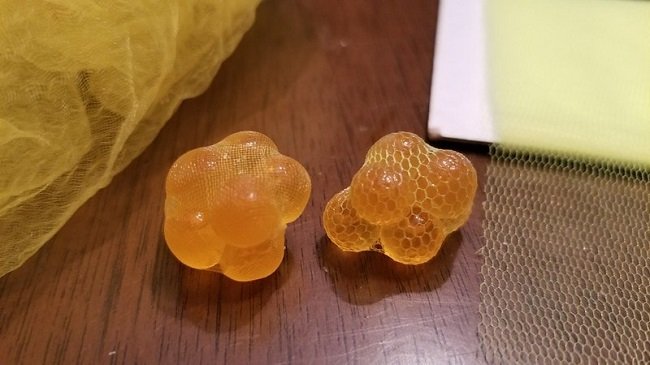
Spawn net can come in rolls, pre-cut squares, or scarves. Each also comes with different hole sizes, as seen in the picture.
I prefer the Blackbird Spawn Net, which is seen on the right side of the picture. It is a wider mesh-hole net that shows more of the eggs but still gives the eggs a bit of color.
Blackbird also has a fine mesh scarf-type net material seen in the picture on the left..
A bonus of the scarf is that it comes in colors that you can’t get elsewhere, like the light purple and yellow, which have worked very well for me at times.
I will use both types of netting, but normally, I only use the scarf in the Chartreuse color for dirtier water because it has more color and stands out better than the other netting.
If you prefer pre-cut spawn netting, you can try the Atlas Brand Spawn Net.
19. Should You Use Floaters In Your Spawn Bag?
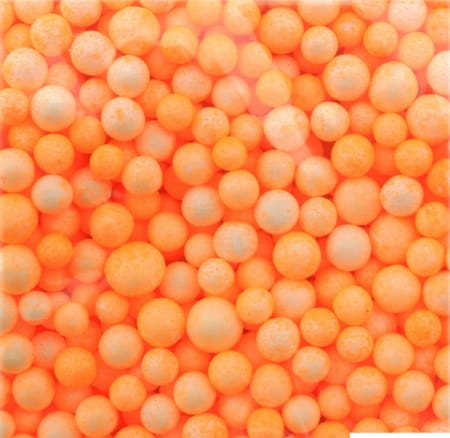
Spawn sac floaters are mini styrofoam balls that you put into your roe bags so they float.
The only time you should use these is when still fishing on the bottom to keep the spawn bag up off the bottom.
20. How Do You Hook A Spawn Bag?
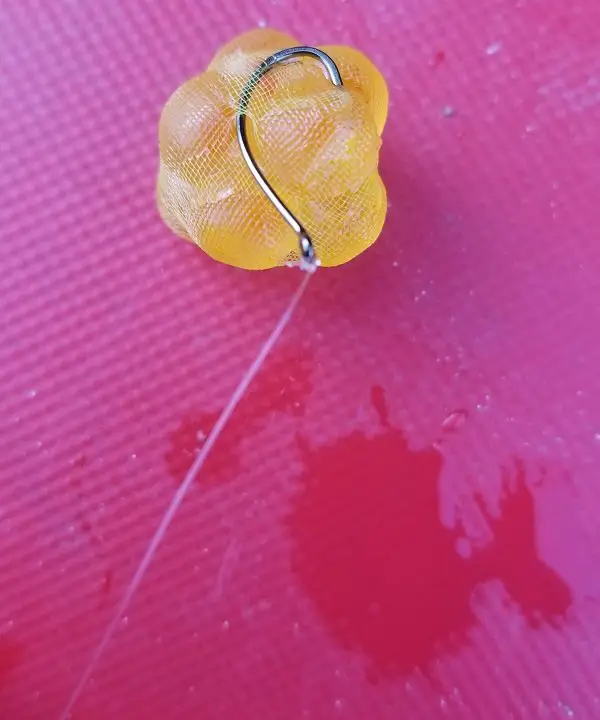
Proper hooking of the roe bag can mean more fish.
I like to hook on the roe bag in a way that does not break any eggs. I like to make sure the hook is on one side of the bag so that it is hidden on all sides except that one side.
If you bury the hook like a lot of anglers do you will damage many of the eggs and the bag will be no good after a couple of drifts.
To be sure I don’t break any eggs, I carefully thread the hook point between a couple of eggs and then turn the hook point out of the bag without breaking any eggs.
Then I try to turn the point back in towards the bag and gently place the point of the hook into the roe bag in a spot that will not break an egg but still penetrate on the hook set. You can see this in the picture.
21. Use a Good Hook and Make Sure It’s The Right Size
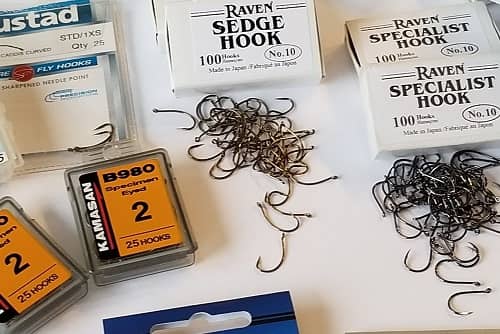
I’ve caught plenty of 30 to 40-pound chinook salmon on size eight hooks. Small but strong hooks catch big fish.
Use a hook that matches the size of the bag!
Too big of a hook means the fish see the hook, and that heavy hook might prevent the bait from drifting naturally. Too small of a hook can close up the gap and make penetration and hooking percentage worse. Too small can also mean it will only grab a small bit of skin and not hold well.
Use chemically sharpened and proven hook that won’t bend or break. I use Raven Specimen Hooks and the very popular Gamakatsu Octopus Hooks.
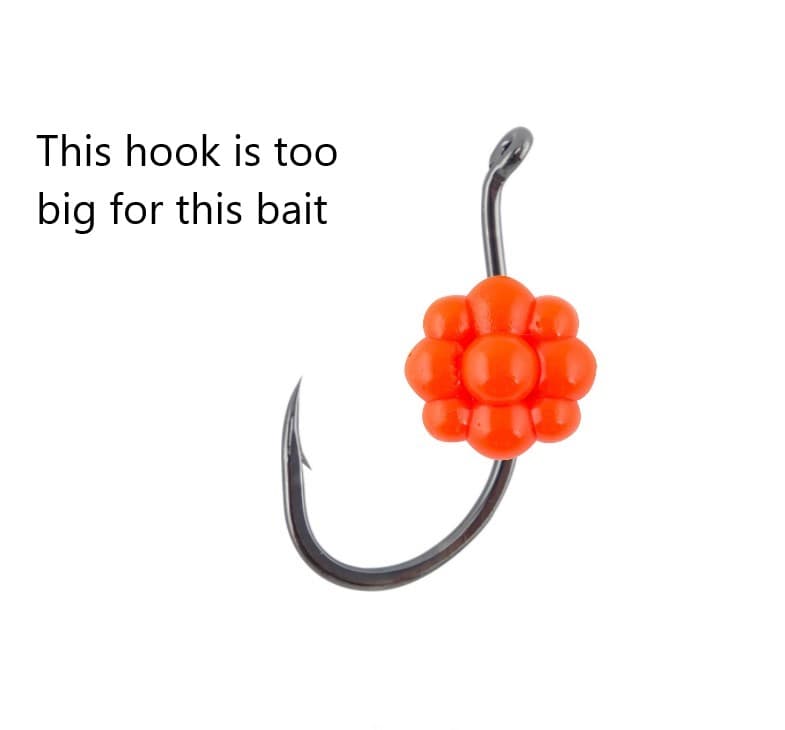
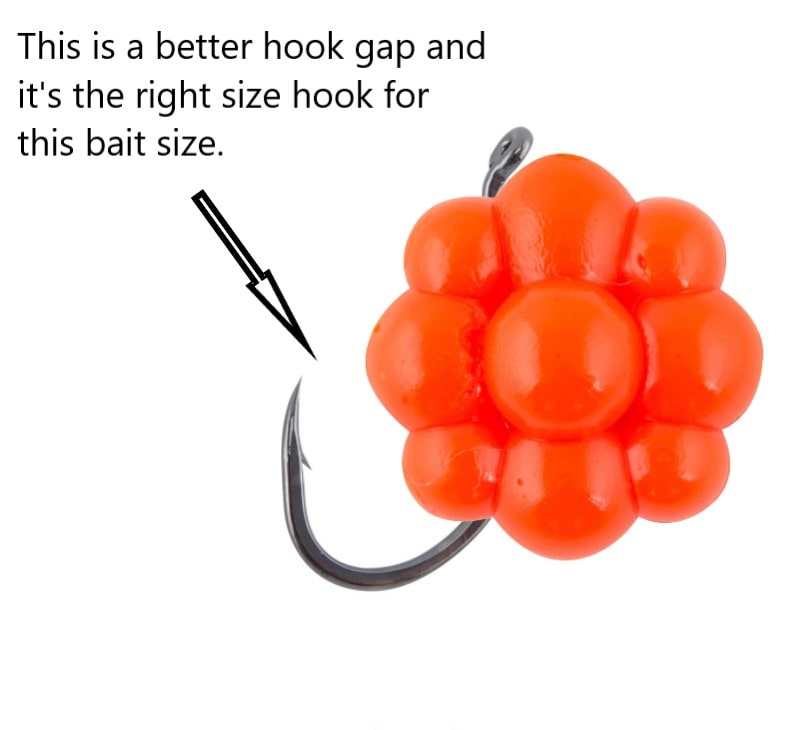
22. Change Your Spawn Bag Often
I change my spawn bags when they start getting beat up with broken eggs or when they start fading color and turning white.
I also gently poke a hole into one of the eggs in the spawn bag after 3 or 4 drifts, or before you change the bag and make another drift.
23. How To Tie A Spawn Bag?
There are a few ways to tie a spawn bag and a few devices that may make it easier for you along with some materials that make tying bags much faster.
Some anglers like the Redwing Tackle Bait Bandit Tying Machine to help them tie their spawn bags faster.
You will also want to get yourself some special rubber tying thread which is fantastic stuff and a must-have for tying spawn bags.
24. Don’t Throw Out Old Roe? When Is Roe To Old To Fish?
I have had roe in my freezer for five years and it still worked well. I have also used roe bags that had gone bad from sitting in my vest or in my car for too long and it was so stinky it almost made me want to puke when I opened the container, but I still caught fish on it.
The fish will eat based on sight, maybe scent so even old roe can work.
So before you throw out a bunch of old stinky spawn bags, put them on a hook, and give them a drift or three, if you can tolerate that smell!
25. How Long Does Roe Last?
In the fridge, un-cured fish eggs should last about 7 to 10 days before getting too stinky.
Salt-cured eggs and eggs using a commercial cure might last a few weeks in the fridge.
As far as freezing eggs, I have pulled out non-cured salmon eggs from the freezer after three years and caught fish on them, and the cured eggs should last a year or two longer.
I also freeze, thaw and re-freeze my eggs over and over again with little to no problems.
The only thing I will stress is that once the eggs get freezer burn they may be slightly deflated, look whitish inside, and they may not work as well. This can happen with both un-cured and cured eggs if they are not stored properly.
26. Storing Fresh Roe
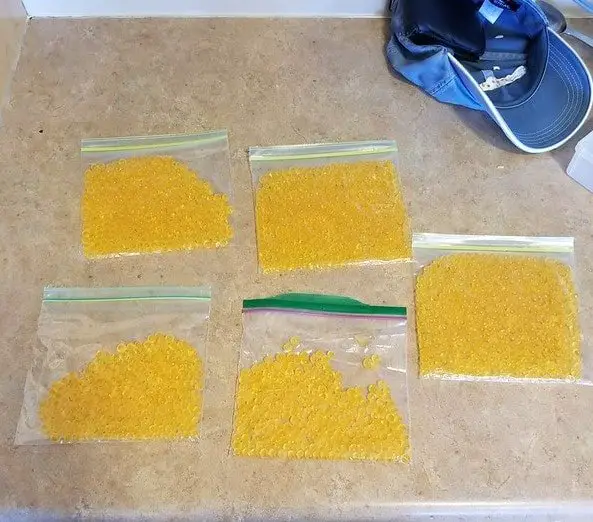
Whether you use zip lock bags or small bottles, I highly recommend storing your eggs in 1 to 3-day serving sizes so that you don’t have to thaw out 2 pounds of roe in a big jar just so you can tie up 20 bags.
I will also tie up spawn bags a freeze them for quick and easy-to-go roe bags. However, doing this too many times seems to dehydrate the eggs and may make your roe bags a bit saggy over time.
27. Can You Freeze Roe Multiple Times?
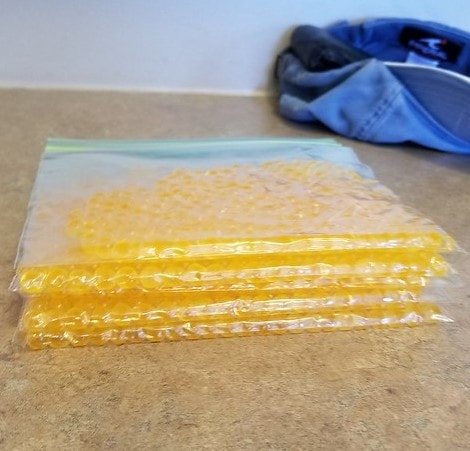
Yes, you can freeze fish eggs 4 or 5 times. You can also freeze your tied-up roe bags 4 or 5 times. I do this all the time with no issues.
But, I do find that refreezing them too many times may dehydrate the eggs or cause freezer burn, which is why I try to limit how many times I refreeze my roe bags. It’s also why I always freeze fresh roe in single day use sizes.
If you have a question about spawn bags leave it in the comment section below.
Tight Lines
Graham

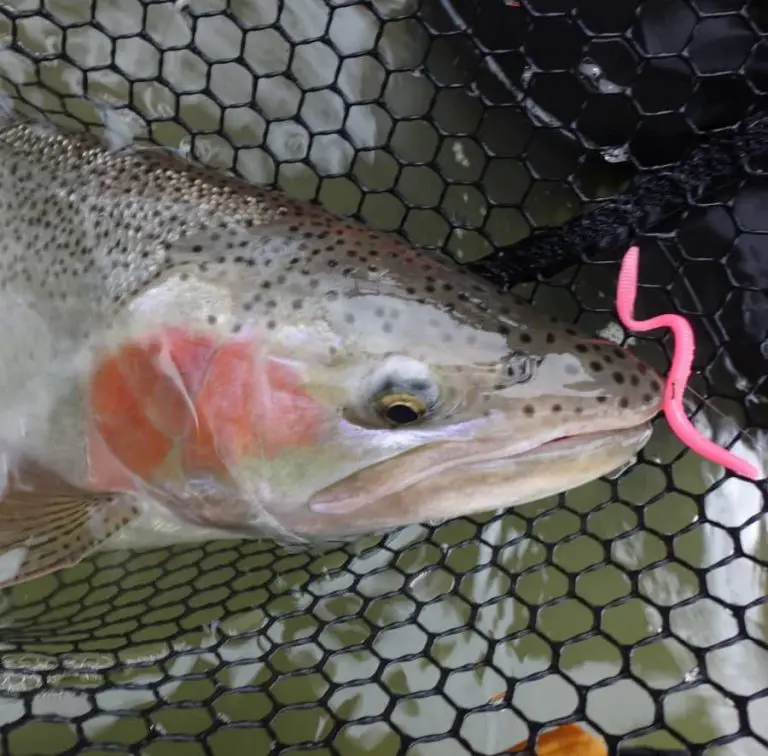
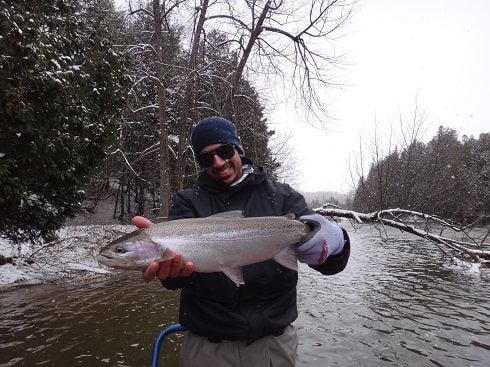
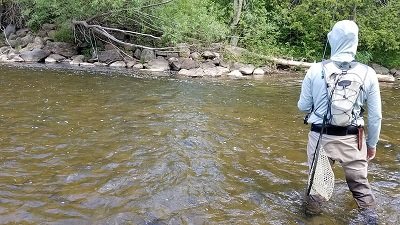
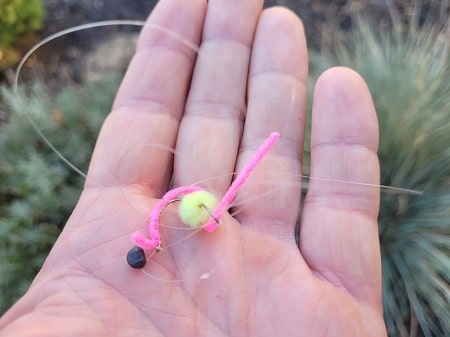
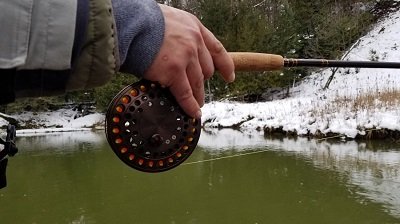
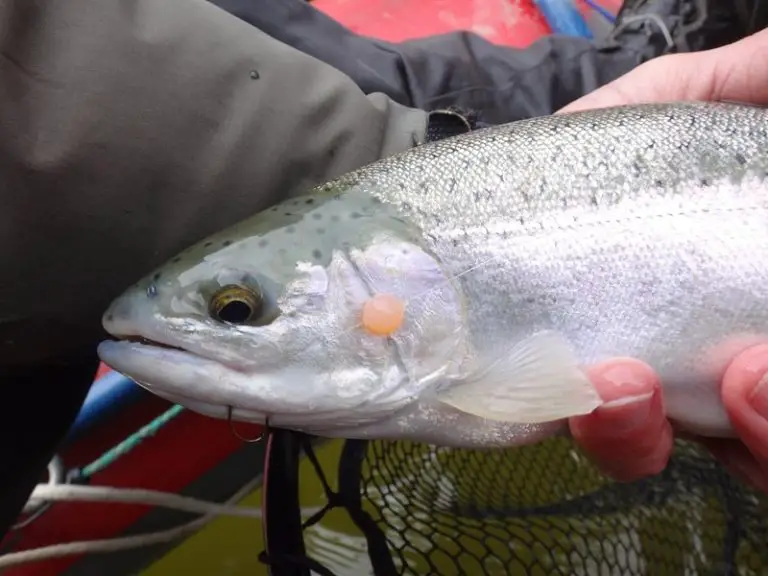
great information thanks
I know this is completely off-topic but do you know any good bass fishing spots in Toronto near the lower humber river or in that area?
Hi John, There is smallmouth bass in the lower ends of most of the GTA rivers. Some rivers have larger numbers than others. There is also bass around the Toronto islands.
Well fish are cold-blooded well fish are cold-blooded I had loose eggs cured them kosher salt put them in a glass jar last year and in the refrigerator 1 year took them today made spawn sacs they looked as fresh and smelled as fresh as the day I put them in the fridge
Hi Graham, dose the simple salt cure work for eggs scraped off of skein or only for loose eggs. Thanks
Hey Liam, I don’t use skein often and when I do, I find the eggs from a skein can shrivel up from a salt cure brine. You are best to use Procure or another store-bought cure for eggs from a skein. Watch this video for an idea on salt cure
thanks for this video. and all you do for us new comers into the steelhead game. much appreciated!. lots of helpful info throughout your articles.
Hey Brad,
Glad you like it, I’m happy to help, don’t forget to tell your buddies.
Graham
You cannot use iodized salt must be kosher salt no chemicals in the salt also don’t smoke using the same hand you bait your hook with another chemical sent trout don’t like
I agree. Kosher salt, pickling salts, and pure sea salts are better. Thanks for the tip.
Is there someplace you can buy fresh uncured eggs so that I can cure myself?
Hi Bill, I don’t know of anywhere that sells uncured eggs. The problem is that uncured eggs go bad within a couple of weeks so stores sell cured roe that can last for months. Many stores around me sell salt-cured eggs and they work great.
Ty for the reply, your website is awesome. Do u still offer guide services? What stores would u recommend?
BC
I also know in some areas it’s illegal to sell uncured eggs. It’s also illegal for someone to sell eggs unless they have a bait license. That way you don’t have guys going down to the river and slicing open a few hundred salmon just so they can sell the eggs. I would start with your local bait shops and shops near the rivers and see if they know how to get uncured roe.
Or find a buddy that has extra that he wants to get rid of.
Great new site Graham!
Thank You, I’m glad you like it.
Can you put tied spawn sacs individually in tinfoil and just pull out a cpl here and there as needed?
Hey Eric,
I don’t see why not, but that seems like a lot of work to wrap them individually like that. I’d maybe do 3 or 4 wrapped up in tinfoil and see how that works. They should store, freeze and thaw just fine when together like that.
Most guys Ziploc bag or baby jar a days-worth of sacs and then store them like that.
Good luck.
Graham
Hi Graham, really really love all your fishing tip pages. They have helped me a lot over the years!! I have heard you MUST river cure right away if you want to use a salt cure. Is this true? What if I don’t want to harvest the eggs at the river, can I still use the salt cure method?
Hey Ray,
I’m glad you’re liking the website, there’s more to come.
As long as you don’t use chlorinated water when you get home it should not affect the eggs or the curing process. Instead, when you get home, you can put your eggs in spring water or distilled water, or probably any water without chemicals, for 5 to 10 minutes to Prince them and let them harden. This will do the same as what river water will do, which is to harden up the eggs a bit so they are less fragile, then do your salt cure, or don’t cure them at all.
Good Luck,
Graham
once spawn bags are tied (fire balls) how to best store those that are unused?
Hey Francis,
It depends on when you want to use them next. They should store in the fridge for a couple of weeks. I will keep them in jars or zip-lock bags.
If you want to keep them for a year or more. Put the bags or jars in the freezer with only about a day worth of eggs.
Good Luck,
Graham
do you find that you catch more on non cured or water hardened eggs, my thought process is that if i dont cure them and tie them into bags then they’ll keep their natural scent and release more juices as they drift.
Hey Joseph,
I prefer to water harden only with no cure, works for me.. the next best is a salt only cure.
Graham
Hmm okay, thats if i catch a loose one though, ever try non cured single eggs but scraped off skein? Does it work the same as milked loose eggs?
I have but uncured Skein eggs tend to be fragile and break too easily. Which sucks when tying the eggs and when fishing them. I use store bought and trout farm trout eggs that have been salt cured, which tend to work very well too, incase you can’t catch a loose hen.
gave it a shot, although i noticed that the uncured scrape was frozen while the cured scrape wasn’t, any idea why and how to prevent it?
Uncured scrape will spoil quickly, 5 to 7 days, so it needs to be frozen. Cured scrape can last months in the fridge so it does not need to be frozen.